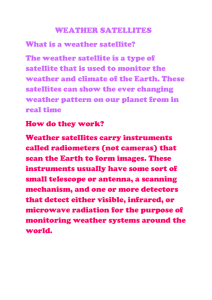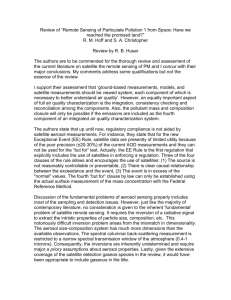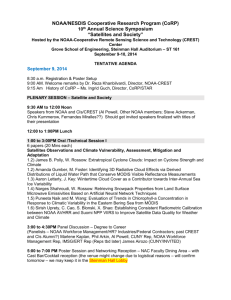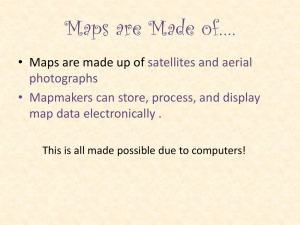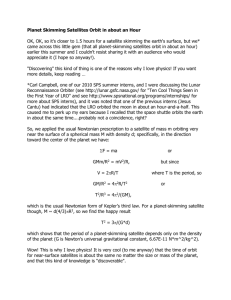Student Report in doc format
advertisement
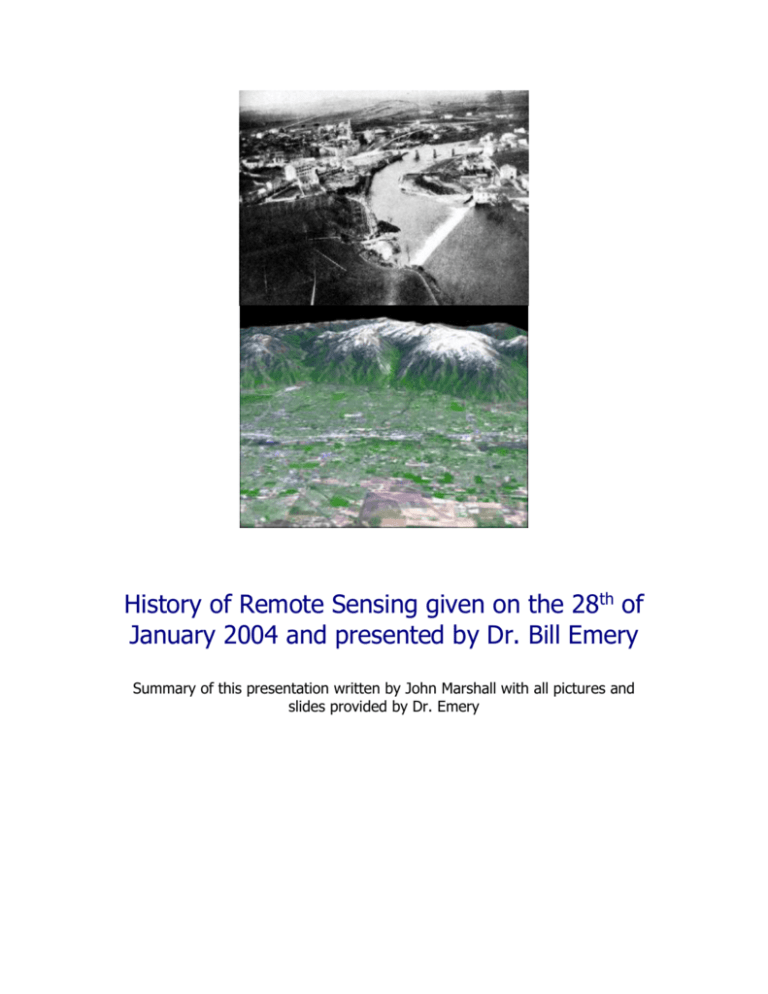
History of Remote Sensing given on the 28th of January 2004 and presented by Dr. Bill Emery Summary of this presentation written by John Marshall with all pictures and slides provided by Dr. Emery Sensores en el Óptico y en el Infrarrojo Felix Tournachon takes a picture of Paris, 1868 In his presentation on The History of Remote Sensing Dr. Emery began with the beginnings of remote sensing, from simple black and white photography to the sophisticated satellites we have today. In its beginning remote sensing was rudimentary as seen in the following slide showing a camera mounted on a kite, yet it provided a new way at looking at the world and a glimpse of what was to come. Sensores en el Óptico y en el Infrarrojo Kite Mounted Camera for Aerial Photo The early advances in remote sensing came not so much with the sensor but with what got the sensor to its “remote” location. These advances consisted of simple ingenuity; putting cameras on pigeons and kites, to new technology such as rockets that would enable cameras to one day be put in orbit. Sensores en el Óptico y en el Infrarrojo First Rocket Photos by Samueal Goddard in 1926 Sputnik, launched by the former USSR broke open not only the space race but also created a new era for remote sensing. Sensores en el Óptico y en el Infrarrojo The world changed with the launch of Sputnik in 1956 America would follow close behind with there first remote sensing satellite called the Television and Infrared Observation Satellite or TIROS-1 launched in 1960. Sensores en el Óptico y en el Infrarrojo TIROS Satellite As Dr. Emery pointed out, most polar orbiting satellites where and still are launched from the west coast. Since the earth rotates under the launcher from east to west once it leaves the ground, water (Pacific Ocean) is below the launch vehicle during its initial and critical stage of flight where if there was a failure it would simply and safely fall into the ocean. As can be seen on the above slide, the solar panels are placed around the satellite, which is indicative of a spin stabilized satellite. The camera can be seen pointed along the axis of the spin but the problem was that the sensor was not pointed at the earth all of the time but instead sometimes pointed into space. Sensores en el Óptico y en el Infrarrojo This was improved upon in the next TIROS satellite by putting the sensor so it pointed through the solar panels, rotating with the satellite (perpendicular to the axis of spin) which allowed more of the earth to be viewed. These satellites were commonly referred as ESSA satellites which was the predecessor to NOAA. Sensores en el Óptico y en el Infrarrojo In order to receive the data, large antennas were set up to receive the signals from the satellites and then the data would be converted for analysis. Eventually though the size on the antennas began to shrink as it was realized that large antennas where not necessary. Dr. Emery also pointed out that since the early images were analog they had to be processed by hand. Below is the first global picture of the world’s weather ever produced. Simple VHF antennas where then added to aid meteorologists in receive the data. Sensores en el Óptico y en el Infrarrojo Eventually technology progressed even further to a three-axis stabilized satellite which came as a result of the cold war. The main earth observation satellite to introduce this technology was ITOS or Improved TIROS Operational System. This was great because the sensor could for the first time point always to the earth yet this also presented a new problem which had to be solved. Since the satellite was no longer rotating it did not distribute the heat from the sun across the entire satellite causing one side to be cold while the other was hot. This was solved through the addition of a gold heat blanket that would protect the satellite from over heating on one side. It wasn’t all that bad though, a big advantage was that for the first time solar panels could be pointed towards the sun at all times. An additional point about the ITOS satellite was that it carried a radiometer. As Dr. Emery points out, the difference between a radiometer and a camera is that a radiometer collects radiation line by line rather than all at once as a camera does. The next is next slide shows the Nimbus satellite which operates on the same principle. Sensores en el Óptico y en el Infrarrojo As technology advanced such as the introduction of gyros, so did the weight of the equipment that supported the new advances. Sensores en el Óptico y en el Infrarrojo •TIROS satellites weighed about 150 kg. •ESSA Wheel satellites weighed about 250 kg. •ITOS satellites jumped up to about 400 kg. •Today’s NOAA and DMSP satellites weigh about 1500 kg. The TIROS-N satellite or TIROS next generation represented a huge step forward in that it was a fully digital system. TIROS-N carried both a Space Environment Monitoring (SEM) suite which included a Solar Backscatter Ultraviolet (SBUV) sensor (Emery slide). TIROS-N satellites also carried the AVHRR sensor or Advanced Very High Resolution Radiometer. The AVHRR is simply a scanning radiometer which senses radiation in the visible, near-infrared, and thermal infrared. It started as a four channel sensor but is currently up to six channels. This sensor which was carried on the TIROS N satellites is still in use today aboard the NOAA POES satellites. Sensores en el Óptico y en el Infrarrojo Spc Rg (mm) Dector Res (km) IFOV (mr) S/N@5% NedT @ 300K MTF @ 1.9 km Tmp Rng (K) Ch. 1 Ch. 2 Ch. 3A Ch. 3B Ch. 4 Ch. 5 0.58-0.68 .725-1.0 1.58-1.64 3.55-3.93 10.3-11.3 11.5-12.5 Silicon 1.09 1.3 sq. >=9:1 Silicon InGaAs 1.09 1.09 1.3 sq. 1.3 sq. >=9:1 >=20:1 InSb 1.09 1.3 sq. HgCdTe HgCdTe 1.09 1.09 1.3 sq. 1.3 sq - - - - - - <=.12K <=.12K <=.12K >.30 >.30 >.30 >.30 >.30 >.30 - - - 180 - 335 180 - 335 180 - 335 AVHRR Sensor Table Along with NOAA’s POES satellites there is the Defense Meteorological Satellite Program (DMSP) which is very similar in terms of its bus when compared to the NOAA POES satellites. The goal of DMSP satellites is obviously to serve the military but they also work with the POES satellites in gathering earth observation data. The main differences between the two systems are with their sensors. One difference is that on the DMSP satellites you have the Operational Line Scanner, which is not as good as the AVHRR but has the added capability of being able to pick up data at night. So where are we headed now? In a word, NPOESS or National Polarorbiting Operations Environmental Satellite System. Basically the goal is to merge NOAA and DMSP satellites into one group. With a cost of 10 billion dollars, NPOESS will combine NASA, NOAA, and Department of Defense (DOD) satellites into one program and provide one place in which to obtain data. NASA will have the overall responsibility while DOD will be in charge of procurement. This change was probably born out of financial reasons and poses many questions for the remote sensing community. Some of the worries include validation problems that may exist plus data dissemination issues. Another words, can you get timely data from the DOD in 24 hours or less. In terms of data validation as Dr. Emery points out, data is only as good as the calibration prior to launch and the validation after. Of course this won’t be the only Earth Observation effort going on in the world. The Europeans have there METOP program which while similar does have different instruments.
